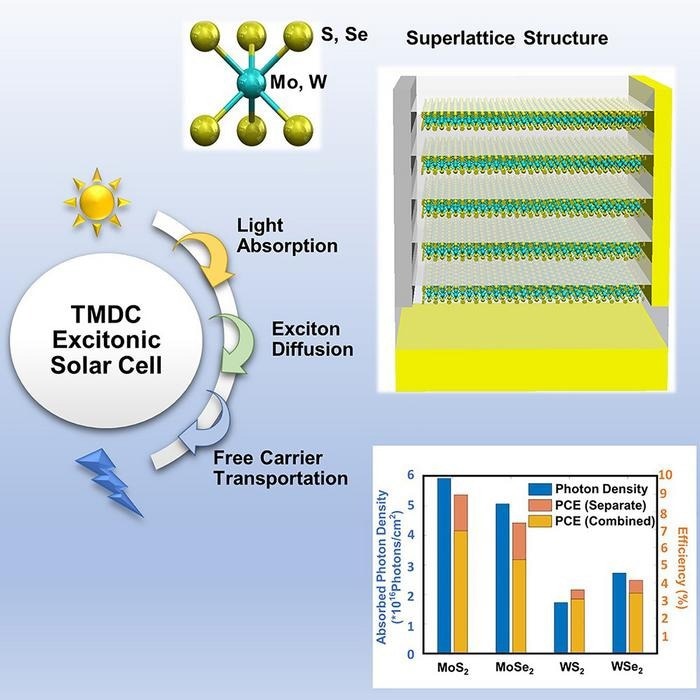When it comes to supplying energy for space exploration and settlements, readily accessible silicon or gallium arsenide solar cells are still too heavy to be delivered by rocket.
 How good can 2D excitonic solar cells be? Image Credit: Device/Hu et al.
How good can 2D excitonic solar cells be? Image Credit: Device/Hu et al.
To solve this issue, a wide range of lightweight alternatives are being investigated, including solar cells composed of a thin layer of molybdenum selenide, which fall under the wider category of 2D transition metal dichalcogenide (2D TMDC) solar cells.
Researchers suggest a device design that can boost the efficiency of 2D TMDC devices from 5% to 12%, as previously proven in the inaugural issue of the journal Device.
I think people are slowly coming to the realization that 2D TMDCs are excellent photovoltaic materials, though not for terrestrial applications, but for applications that are mobile—more flexible, like space-based applications. The weight of 2D TMDC solar cells is 100 times less than silicon or gallium arsenide solar cells, so suddenly these cells become a very appealing technology.
Deep Jariwala, Study Lead Author, University of Pennsylvania
Deep Jariwala is also a Device advisory board member.
While 2D TMDC solar cells are less effective than silicon solar cells in terms of efficiency, they produce more electricity per weight, a property known as “specific power.” This is due to the fact that a layer of 3–5 nm thick—over a thousand times thinner than a human hair—absorbs sunlight at a rate similar to commercially available solar cells.
Because they are only a few atoms thick, their extreme thinness earns them the label “2D”—they are termed “flat” because they are only a few atoms thick.
High specific power is actually one of the greatest goals of any space-based light harvesting or energy harvesting technology. This is not just important for satellites or space stations but also if you want real utility-scaled solar power in space. The number of solar cells you would have to ship up is so large that no space vehicles currently can take those kinds of materials up there in an economically viable way. So, really the solution is that you double up on lighter weight cells, which give you much more specific power.
Deep Jariwala, Study Lead Author, University of Pennsylvania
Because the true capacity of 2D TMDC solar cells has yet to be realized, Jariwala and his colleagues have worked to improve the cells’ efficiency even further. Typically, the performance of this type of solar cell is tuned by fabricating a series of test devices, but Jariwala’s team believes it is critical to do so computationally.
Furthermore, the team believes that to fully push the limits of efficiency, it is critical to correctly account for one of the device’s defining—and challenging to model—features: excitons.
Excitons are formed when a solar cell absorbs sunlight, and their predominance is responsible for the high solar absorption of a 2D TMDC solar cell. The solar cell generates electricity by channeling the positively and negatively charged components of an exciton to different electrodes.
By simulating the solar cells in this manner, the team was able to create a design with twice the efficiency of what had previously been achieved experimentally.
The unique part about this device is its superlattice structure, which essentially means there are alternating layers of 2D TMDC separated by a spacer or non-semiconductor layer. Spacing out the layers allows you to bounce light many, many times within the cell structure, even when the cell structure is extremely thin.
Deep Jariwala, Study Lead Author, University of Pennsylvania
Jariwala adds, “We were not expecting cells that are so thin to see a 12% value. Given that the current efficiencies are less than 5%, my hope is that in the next 4 to 5 years people can actually demonstrate cells that are 10% and upwards in efficiency.”
According to Jariwala, the next step is to consider how to achieve large-scale, wafer-scale production for the proposed design.
Jariwala concludes, “Right now, we are assembling these superlattices by transferring individual materials one on top of the other, like sheets of paper. It’s as if you’re tearing them off from one book, and then pasting them together like a stack of sticky notes. We need a way to grow these materials directly one on top of the other.”